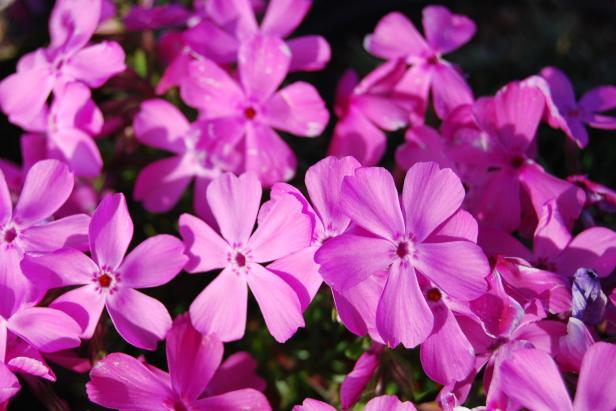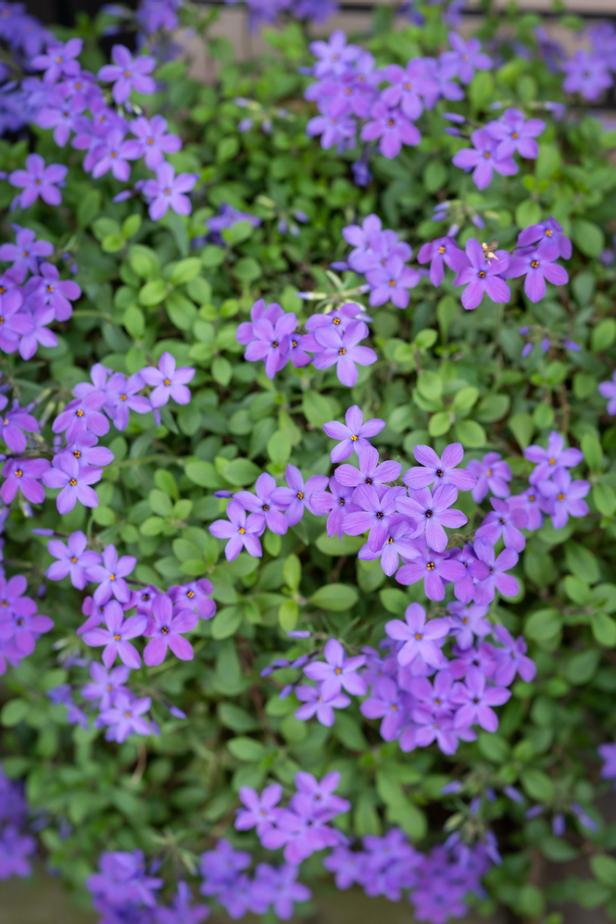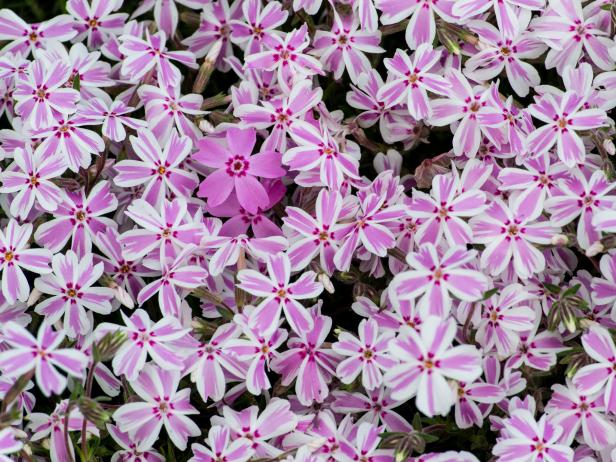Growing Creeping Phlox and Moss Phlox Groundcovers
Learn how to select the perfect phlox ground cover for your garden, and how to grow both creeping phlox and moss phlox successfully.

Costa Farns
Phlox subulata 'Drummond's Pink.'

A well-designed garden beckons us closer, drawing us toward the earth where tiny wonders may be found. While tall, dramatic specimens create obvious impact in the landscape, groundcover plants like creeping phlox weave endearing layers of detail, blending hard lines with their blankets of color.
Beyond their understated beauty, flowering ground covers lend valuable services to the ecosystem, like hosting beneficial insects, feeding pollinators and securing soil to prevent erosion.
Phloxes are incredibly popular and are found in many forms. The creeping species are useful for crafting a beautiful, beneficial groundcover in almost any garden. While many resources broadly refer to all phlox ground covers as "creeping phlox," it is important to specify two distinct types: Phlox stolonifera and Phlox subulata. These species will be differentiated in greater detail below.
This guide will help you choose the correct phlox for your space — whether it’s a woodland edge, cottage garden, retaining wall, patio container, or native xeriscape. Whichever plant suits your space, you can bet on a charming display of spring blooms and reliable, perennial performance from each type of phlox ground cover.
Identifying and Choosing the Right Creeping Phlox
Confusingly, many online sources use the term "creeping phlox" interchangeably for both Phlox stolonifera and Phlox subulata. Differentiating between the two will help you choose the right species for your space as they each fill a different niche. For the purposes of this article, Phlox stolonifera will be known as creeping phlox, while Phlox subulata will be called moss phlox (which is consistent with most scientific literature for each species). Here, we will refer to both species collectively as groundcover or low-growing phlox.
While both wildflower species are reliable spring-blooming, semi-evergreen perennial ground covers, they have different needs. While this may seem confusing at first glance, it’s beneficial for gardeners to understand the differences. Read on, and you’ll find that there is a phlox fit for most any flower bed.
Creeping Phlox
Phlox stolonifera is most widely understood as true creeping phlox. This woodland phlox is native to the Appalachian region; it thrives in part-shade, along the edge of taller plantings or nestled into dappled light. In warm southern regions, this species requires some summer shade. Gardeners further north can typically enjoy this phlox in sunnier spots. Plant creeping phlox into soil that is rich with organic matter, moist and very well-draining.

Shutterstock / Paul Atkinson
Creeping phlox naturalizes readily, creating a blanket of blooms in shades of blue, purple, pink and white. In late spring, clustered flowers are loosely gathered, hovering up to 12 inches above the thick, ground covering foliage. Its leaves are oval shaped with a leathery feel. Compared to Phlox subulata, the visual carpeting effect of creeping phlox is less concentrated, with more breathing room between foliage and flowers.
Common Name: Creeping Phlox or Star Rock Phlox
Botanical Name: Phlox stolonifera
Hardiness Zones: 5-8
Flowering Time: spring to early summer
Notable Varieties: Blue Ridge, Sherwood Purple, Pink Ridge, Home Fires
Moss Phlox
Phlox subulata is sometimes also referred to as creeping phlox but is more specifically known as moss phlox or moss pink. This densely flowering perennial ground cover thrives in full-sun spaces like xeriscapes, south-facing slopes or rock gardens. It tolerates less fertile and sandier soils than creeping phlox, while also insisting on exceptional drainage. Southern gardeners may find that moss phlox benefits from a bit of afternoon shade.

2013, HGTV/Scripps Networks, LLC. All Rights Reserved.
Phlox subulata 'Candy Stripe.'
Moss phlox has prickly, needle-like leaves that produce a prolific blanket of spring blooms reaching about 6 inches tall. The flowers tend to have dark markings toward the center and notched petals, unlike the smooth edges of creeping phlox. Compared to Phlox stolonifera, the visual carpeting effect of moss phlox is lower, tighter and more uniform — similar to a cushion of moss. Are you trying to fill unsightly spaces between pavers or searching for a dramatic display of color to drape a slope or retaining wall? Moss phlox is a simple solution for these tricky-to-fill gaps in the garden. Phlox subulata is commonly found in shades of violet, pink and white.
Common Name: Moss Phlox, Moss Pink (also sometimes called creeping phlox)
Botanical Name: Phlox subulata
Hardiness Zones: 3-9
Flowering Time: spring
Notable Varieties: Vivian White Blanket, Candy Stripe, Emerald Blue, Fort Hill
When shopping for phlox, remember or write down the botanical name of your desired species. Also called the scientific or Latin name, this is the two-part name that is typically italicized (Phlox stolonifera or Phlox subulata). Using the proper botanical name will ensure you find the right species for your space at the garden center.
How to Plant Phlox Ground Covers
Preparing a Bed for Phlox
Both creeping phlox and moss phlox need soil that drains exceptionally well. Whether you’re preparing a shady pathway for Phlox stolonifera or a sunny rock garden for Phlox subulata, incorporate plenty of organic matter into the soil to ensure proper drainage and to promote air circulation for healthy roots. Moss phlox tolerates relatively low fertility and sandier soils.
Suitable amendments include leaf mold, compost, peat moss, well-rotted manure, sand (in heavy clay areas) or soil conditioner, depending on the structure of your soil and the amendments accessible to you. Utilizing locally abundant resources for soil amendments is an economical and sustainable approach; ask your local garden center or cooperative extension service for recommendations. Some municipalities now produce their own organic compost and leaf mold for residents to purchase at a low cost.
Planting Creeping or Moss Phlox
Starting seeds for creeping or moss phlox is a slow process; after germination, the young starts take many months to reach maturity. This is likely why creeping and moss phlox seeds are harder to come by than those of other phlox species. Instead, purchase phlox ground cover plants from your local garden center or ask a friend for a cutting. Autumn is the best season for transplanting perennials like phlox, but it can be done anytime, as long as plants are watered and protected from harsh elements.
Phlox groundcover plants spread readily, but they are most impactful when planted en masse.
Growing Garden Phlox
Learn how to plant, grow and care for the perennial Phlox paniculata in your garden.
Plan to purchase at least one full tray of your chosen variety (at least 12-18 plants). Measure and draw a diagram of your garden space to determine how many plants you will need to fill it, planning for 12-24 inches between each phlox. With many cultivars now commercially available, you are sure to find a creeping or moss phlox — either locally or from a mail-order nursery — that suits your garden’s style.
Whichever phlox you’ve selected, planting is straightforward and similar. After preparing the soil, transplant your phlox 12-24 inches apart, and water well to get them started. Phlox stolonifera needs ample water in its first year but is quite drought tolerant once established. Phlox subulata has low-to-average water requirements. Surrounding new plantings with a layer of mulch (ideally leaf mold) helps keep moisture consistent in the soil and supports healthy microbial activity for vigorous root growth.
Phlox Propagation
Both Phlox stolonifera and Phlox subulata can be easily propagated, either to share with friends or to transplant throughout your landscape. Divide well-established phlox ground covers in spring; simply dig up a portion of the happily spreading plant and gently pry the root ball in half, untangling the foliage with your fingers. Replant one half in the original location and transplant or pot up the second half. Alternately, cuttings can be taken from phlox stems and dipped into a rooting hormone before potting; this stem propagation is most successfully done in autumn. With its ample spreading habit and ease of propagation, phlox groundcover is an economical addition to the garden, as well as a lovely one.
How to Care for Phlox Groundcovers
Fertilizing Phlox
Creeping and moss phlox, being wildflowers, do not require highly nutritious soil. However, they may benefit from a slow-release, organic fertilizer in areas where soil is very depleted. A soil test can help you determine your deficiencies. Look for an all-natural product that is labeled for flowers and has beneficial, biological ingredients like mycorrhizae for healthy roots. Selecting a flower-specific fertilizer will help avoid the over-application of nitrogen, which has adverse environmental impacts, can kickstart weed growth and puts a damper on flower production. Always follow the application instructions on each fertilizer package and only use fertilizer when it is truly needed.
Weeding Phlox
The most effective way to suppress weeds is through a layer of organic mulch; 2-3 inches of straw, pine bark or leaf mulch (also known as leaf mold) around your plants will keep weeds at bay as well as help retain moisture and protect roots from the elements. Mulch is key for establishing healthy creeping phlox, which prefers consistently moist (albeit well-draining) soil. Moss phlox also benefits from mulch, which drastically reduces the need to water and can make drought-tolerant plants like this one (almost) effortless to maintain.
Phlox Pests and Disease
Creeping and moss phlox are relatively deer and pest-resistant, but there are a few potential issues to monitor. In hot and sunny areas, spider mite infestations may arise. In wetter areas, slugs may set up camp. Pruning and deadheading your phlox groundcover to relieve the plants of old, dead growth helps with air circulation — the key to preventing powdery mildew. In every garden, maintaining healthy soil and plants is the best way to avoid the stresses of pests and disease.
Phlox Ground Cover Maintenance
Annual pruning of both creeping and moss phlox will ensure abundant blooms every spring, as well as help to keep disease at bay. As the plants age, dead growth accumulates underneath the upper layer of verdant, flowering stems. Pruning out the old, brittle growth can aid the plants in regenerating and reaching their floriferous potential. Simply lift up the healthy top growth and use pruners to snip dead stems back to ground level. As blooms fade, deadhead leggy flowering stems to encourage their renewal.
Designing Gardens With Phlox Groundcovers
Creeping phlox is well suited to English-style cottage or woodland gardens. It even has a certain fairy garden vibe. Ecologically, it is a perfect wildflower for riparian landscapes and rain gardens. In permaculture practice, it is recommended as an understory plant, layered in the canopy of useful trees, shrubs and perennial herbs. New Moon Nursery recommends pairing Phlox stolonifera with heuchera, columbine or sedge for a varied, colorful design. For container gardens, try pairing creeping phlox as a low, trailing element alongside other taller, shade-friendly plants like ferns, hostas or Solomon’s seal.
Design Tips for Moss Phlox
Planting moss phlox is like coloring with bright crayons, livening empty spaces with sweeping strokes. Use Phlox subulata to soften the hard edges of retaining walls, pavers and rocky slopes. In sunny, drought-tolerant pollinator plantings, New Moon Nursery proposes pairing moss phlox with coneflower, coreopsis, prairie dropseed, and bluestar. In addition to carpeting the ground, moss phlox can be used as a trailing component in container garden designs. Be sure to pair it with other drought-tolerant plants so you aren’t tricked into overwatering. With its early spring bloom time, planting moss phlox with spring-flowering bulbs like daffodils, tulips and hyacinth creates a picture-perfect seasonal container display.

.-Battle-on-the-Beach-courtesy-of-HGTV.-.jpg.rend.hgtvcom.196.196.suffix/1714761529029.jpeg)












































